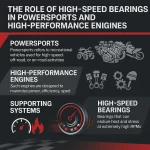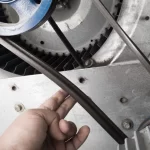The railway is one of the most commonly used transport due to which many people use it daily. Due to the unique design and rigorous manufacturing process, the Railway Bearings are capable of operating at optimum levels. To help you understand better, this blog covers everything you need to know about and types of railway bearings.
Railway bearings are one of the most important components of a railway system, and they play a critical role in the operating mechanism of railway coaches. Railway bearings are commonly used in locomotives, traction engines, transmissions, axles, etc. In this article, we will take a close look at what railway bearings are, how they work, why they are so important.
What is the importance of Railway Bearings?
Railways are the most commonly used transportation worldwide and due to this fact are used by lakhs of people every day for intercity or intra-city transportation. To offer optimal working and ensure efficiency, Railway bearings are an essential part of keeping the trains running smoothly. By reducing friction between the wheels and the rails, they help to keep the train moving forward with less effort. In addition, railway bearings can also help to protect the wheels and rails from wear and tear.Roller Bearings: Offering Advantages as Railway Bearings
Rolling bearings are used in railways because they offer many advantages over other types of bearings. They are able to carry higher loads, operate at higher speeds, and last longer than other types of bearings. In addition, rolling bearings create less friction, which can help to reduce wear on the rails and wheels.What is the role of Railway Bearings in ensuring safety?
Properly maintained and functioning bearings can help to avoid derailments, collisions, and other accidents. In addition to their safety benefits, railway bearings also play a role in reducing noise pollution and vibration since bearings are critical components of machinery to ensure better operability they are designed in a way to offer better alignment and fitment.What is the application of Railway bearings?
Railway bearings are used in a variety of applications, including locomotives, passenger cars, and freight cars. They are also used in other railway vehicles, such as cranes and maintenance equipment. Railway bearings play a vital role in the safe operation of railways by providing smooth and consistent operation of trains.Types of Railway Bearings
There are many different types of railway bearings, each designed for specific applications and operating conditions. Ball bearings are the most common type of railway bearing and are used in a variety of applications, including locomotives, passenger cars, and freight cars. The most common types of railway bearings are:- Roller bearings: these bearings use rolling elements (balls or cylinders) to support the load, reducing friction and allowing smooth operation. They are typically used in high-speed applications such as locomotives. However, they can be noisy and may require more maintenance than other types of railway bearings.
- Plain bearings: these bearings rely on a sliding contact between the bearing surface and the journal (the rotating shaft). Plain bearings are often used in lower-speed applications such as passenger cars.
- Magnetic bearings: these bearings use magnetic fields to support the load, eliminating friction altogether. They are typically used in high-speed applications such as electric trains.
- Ball Bearings: Ball bearings are similar to roller bearings, but they use balls instead of cylinders. Ball bearings are quieter than roller bearings and require less maintenance. However, they can be less durable and may not last as long as roller bearings.
- Tapered Roller Bearings: Tapered roller bearings are a type of railway bearing that is designed for use on curved rails. Tapered roller bearings have a tapered shape that helps them grip the rail better, which reduces friction and makes the train run smoother. However, tapered roller bearings can be more difficult to install and may require special tools.



















